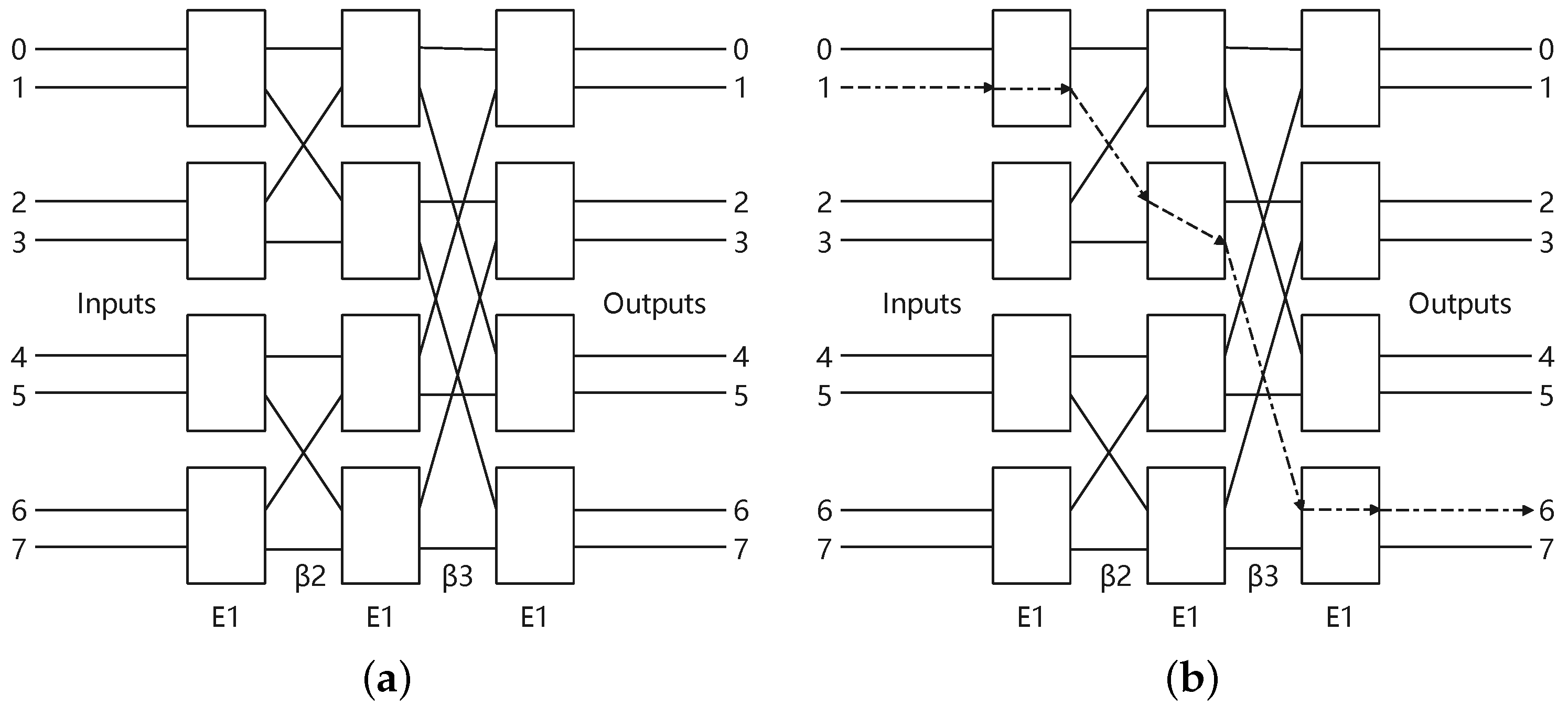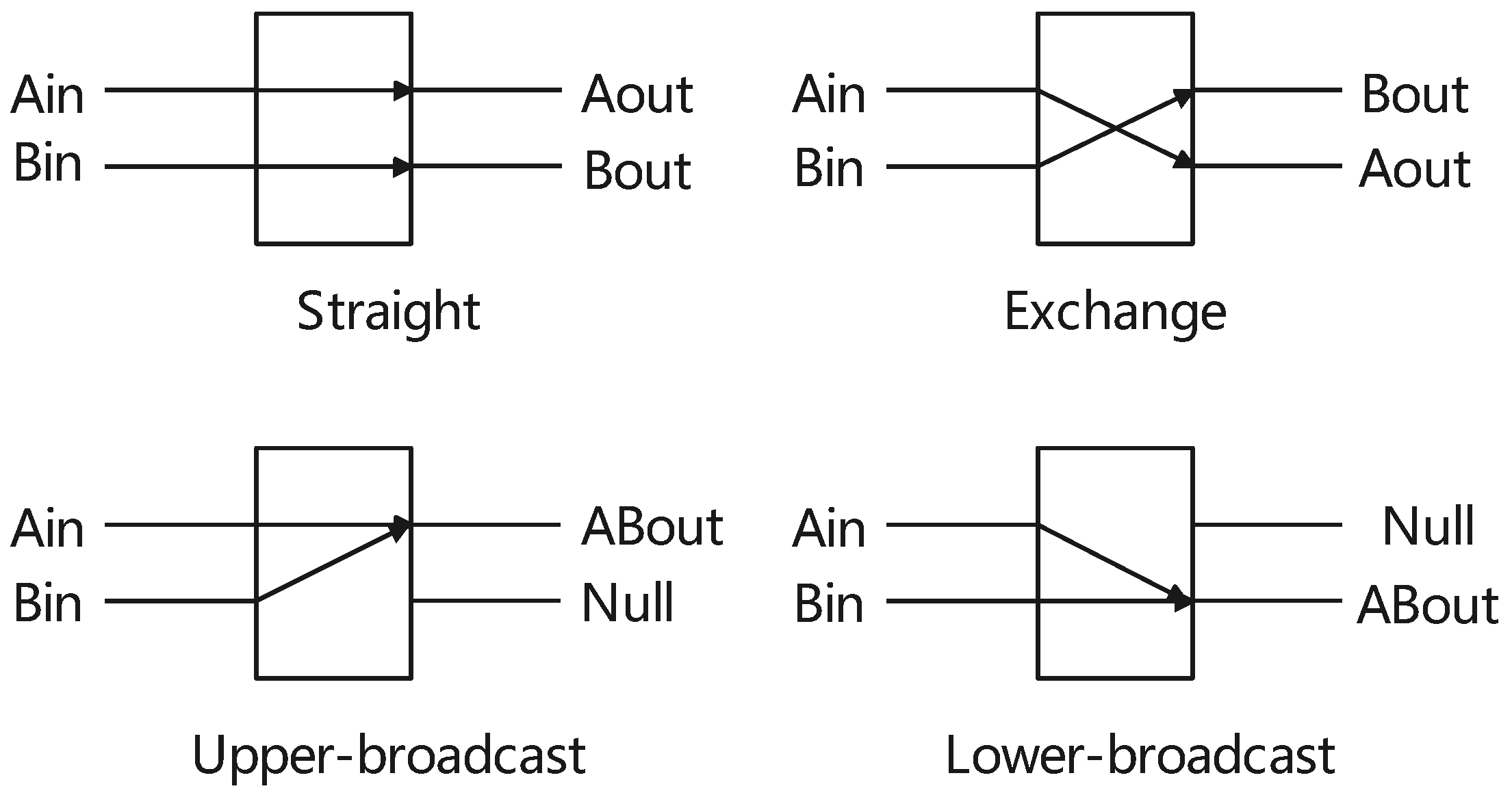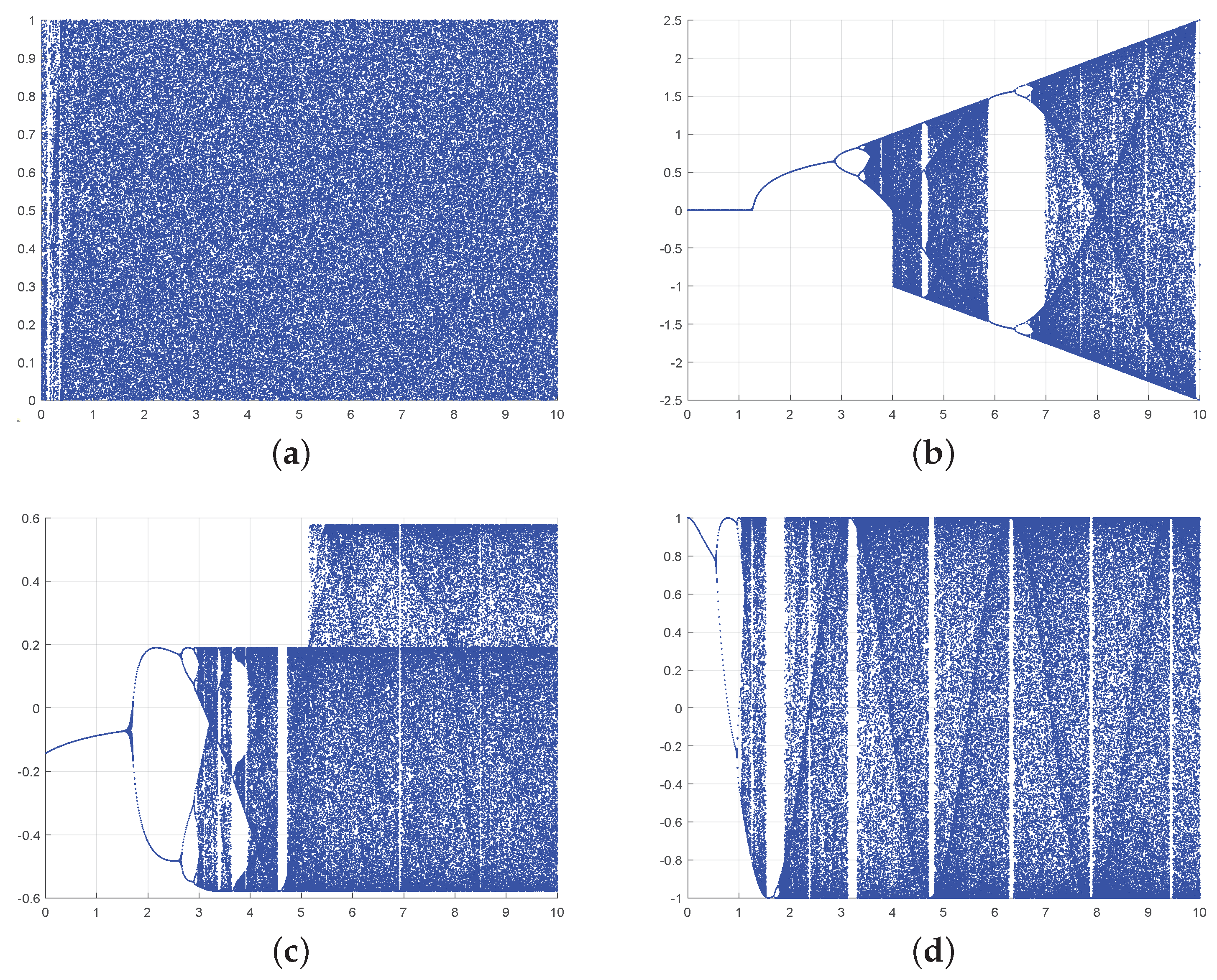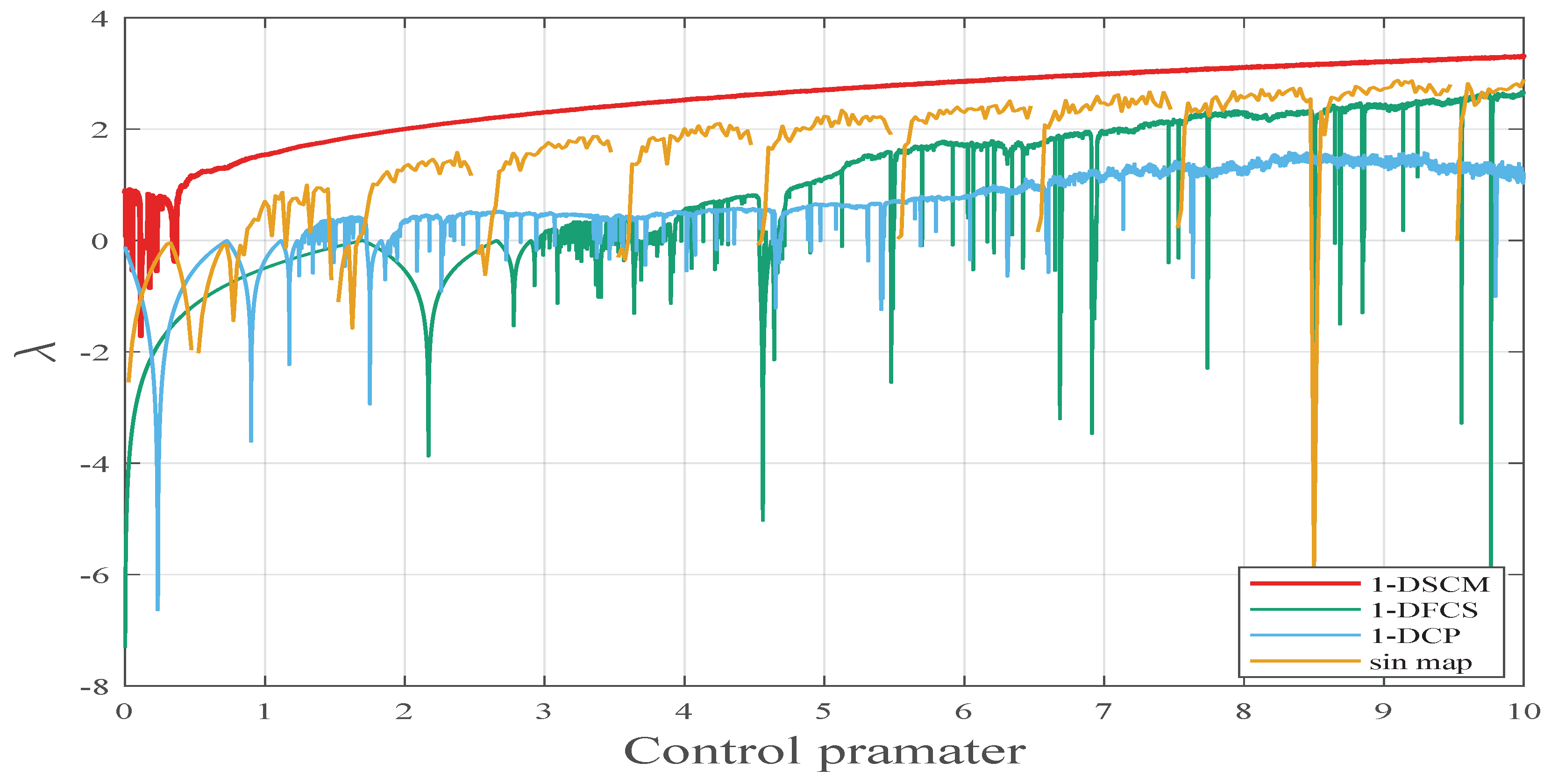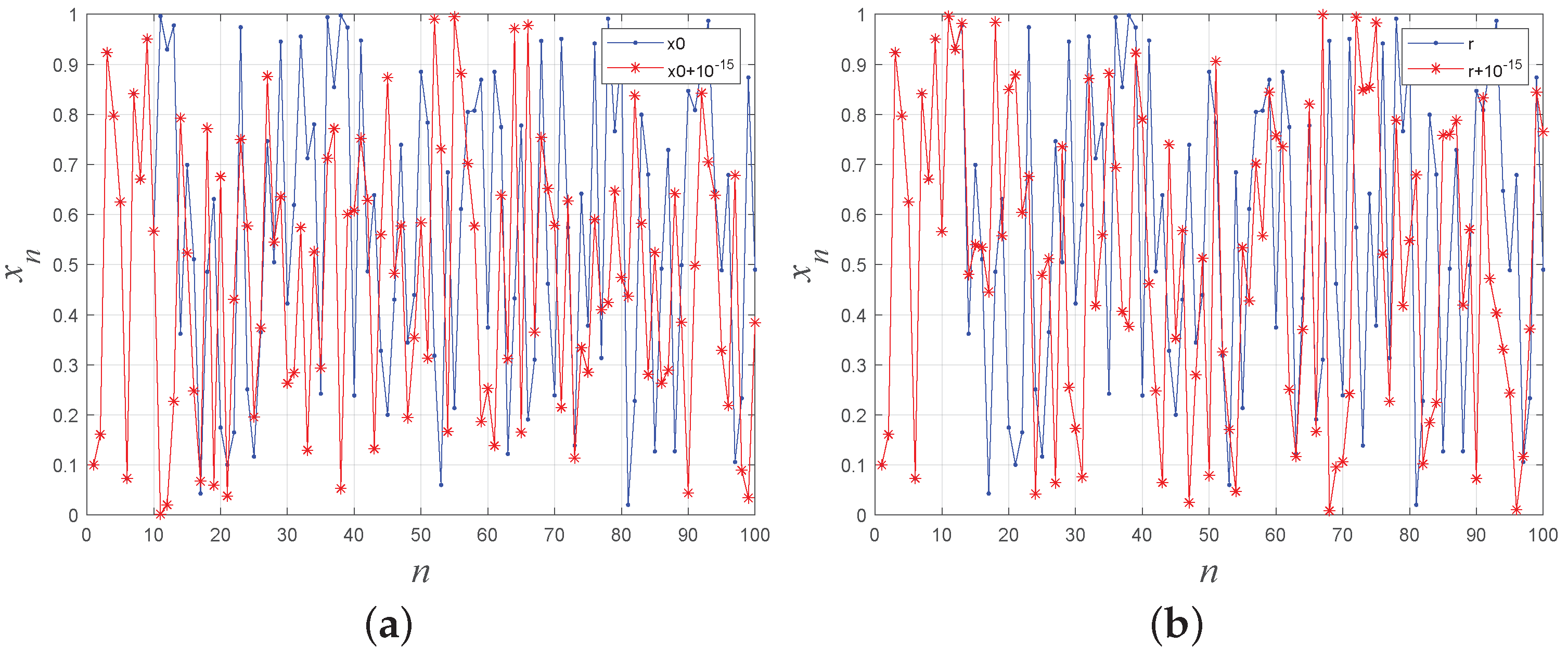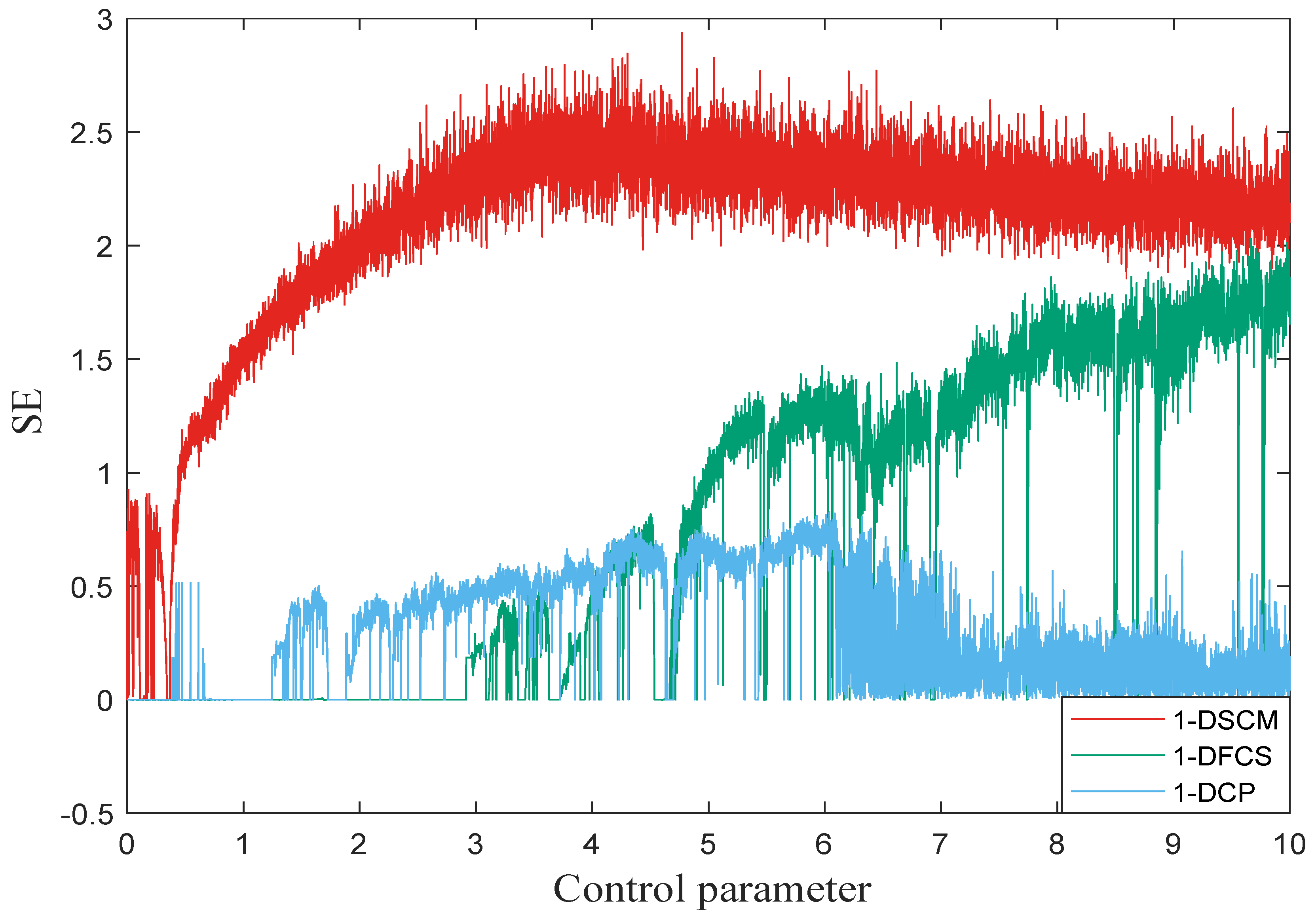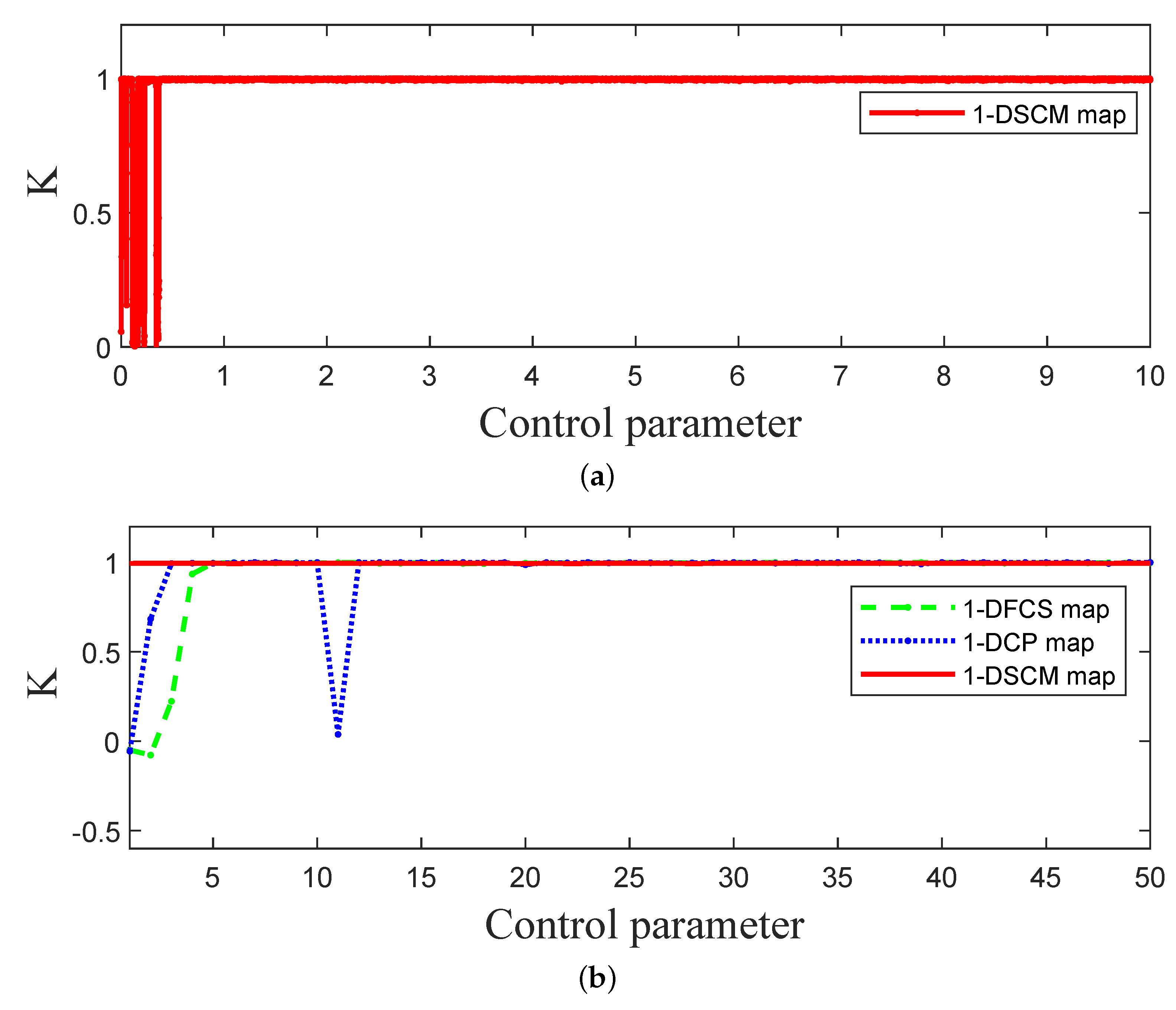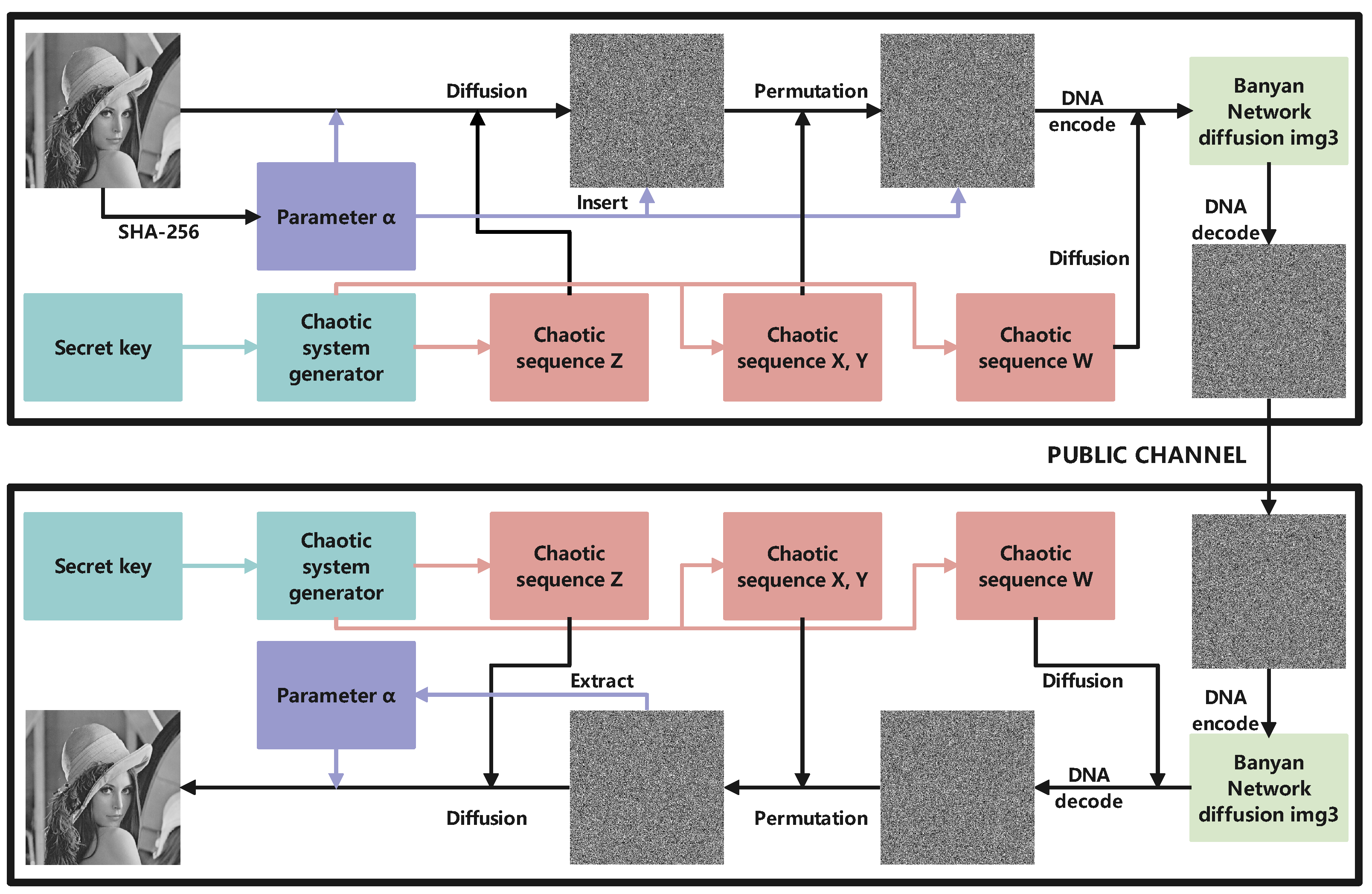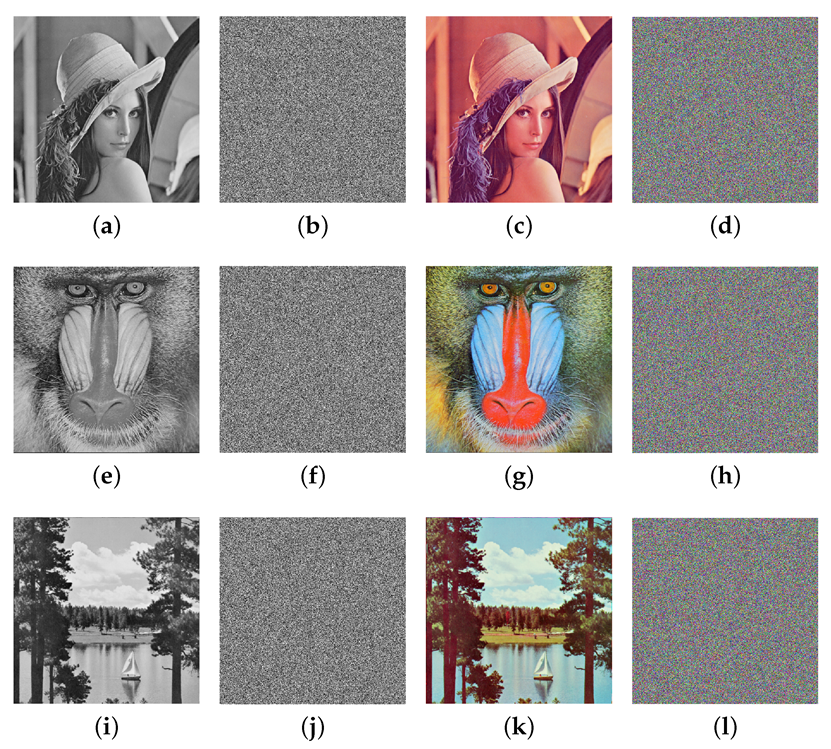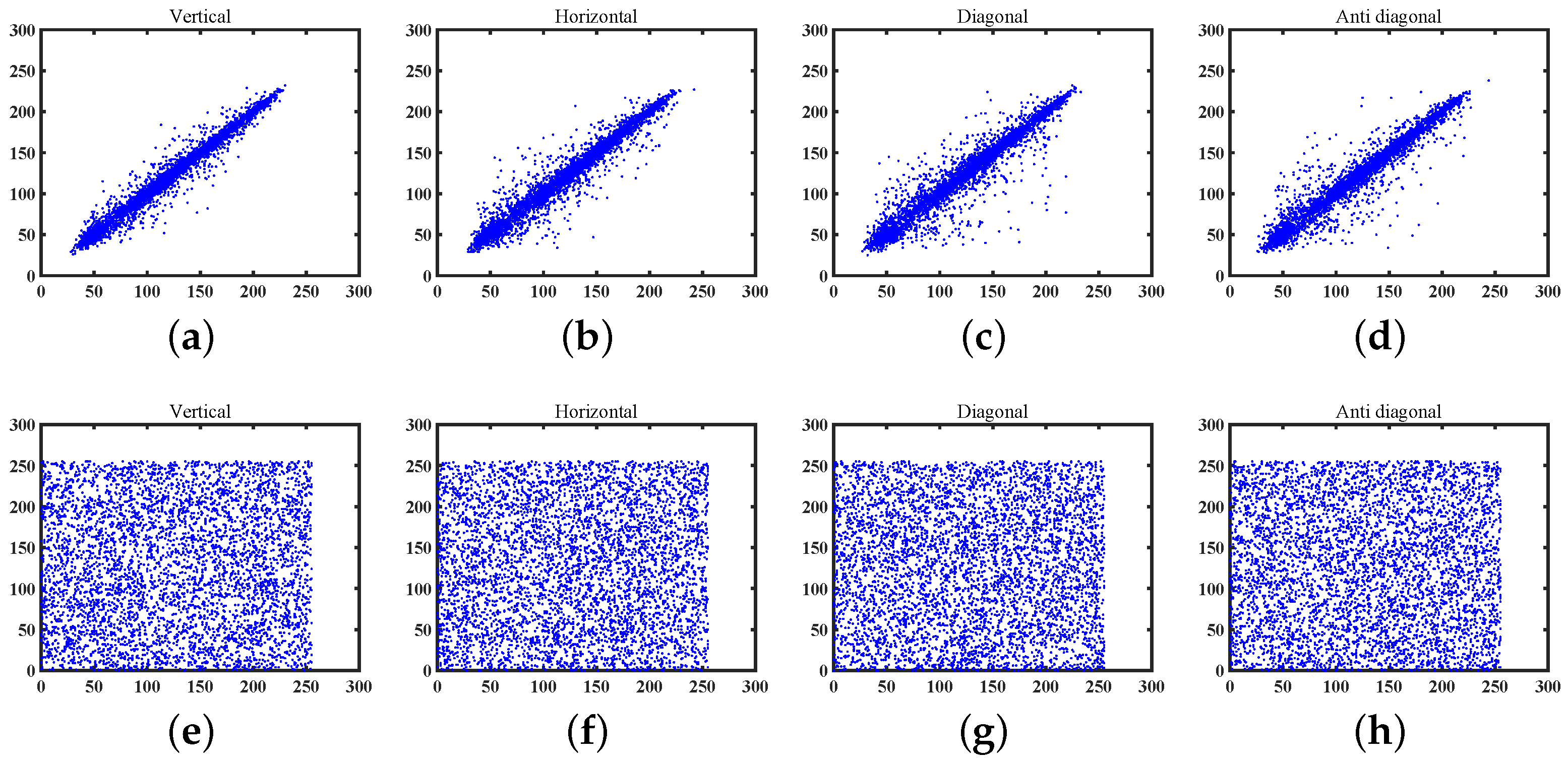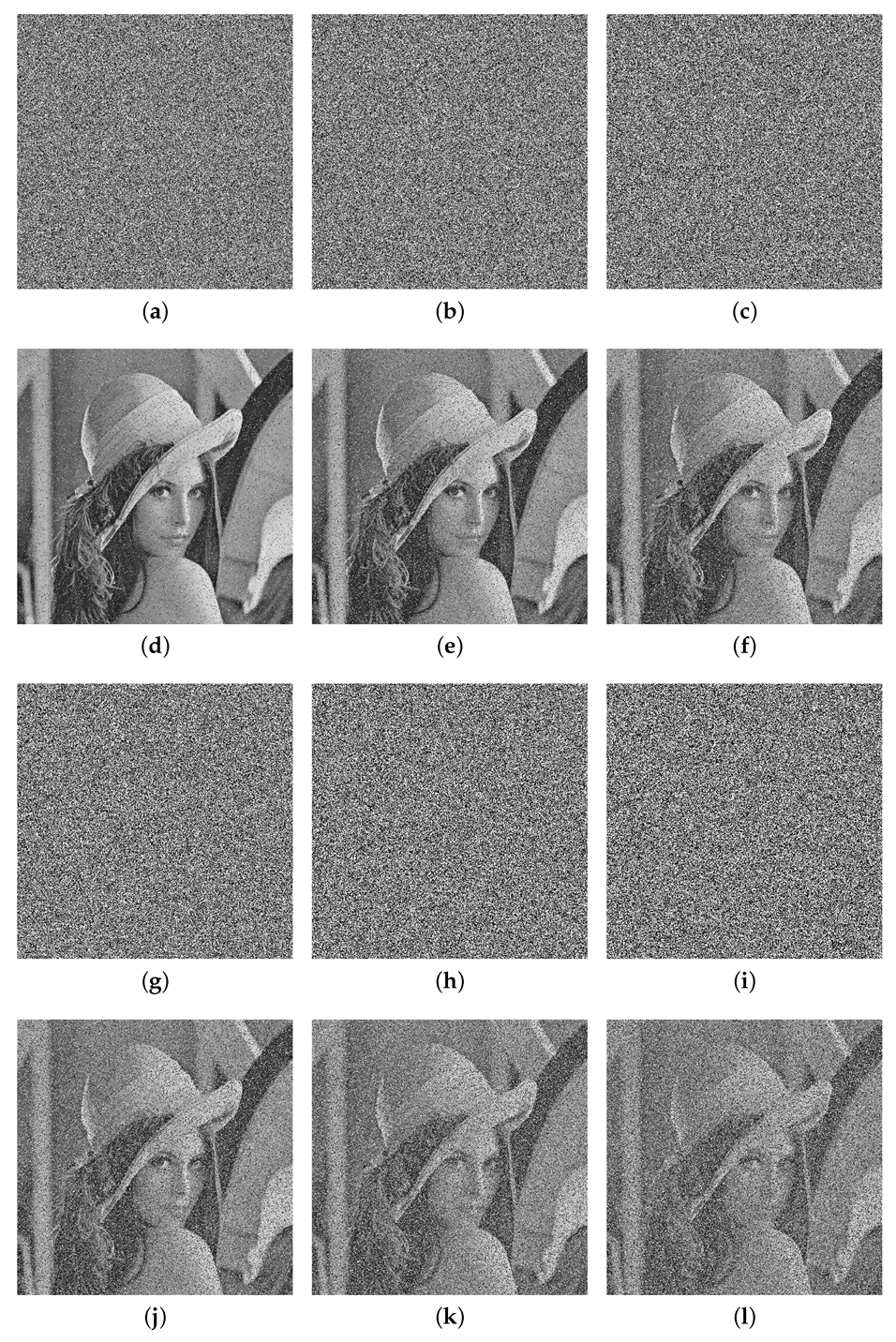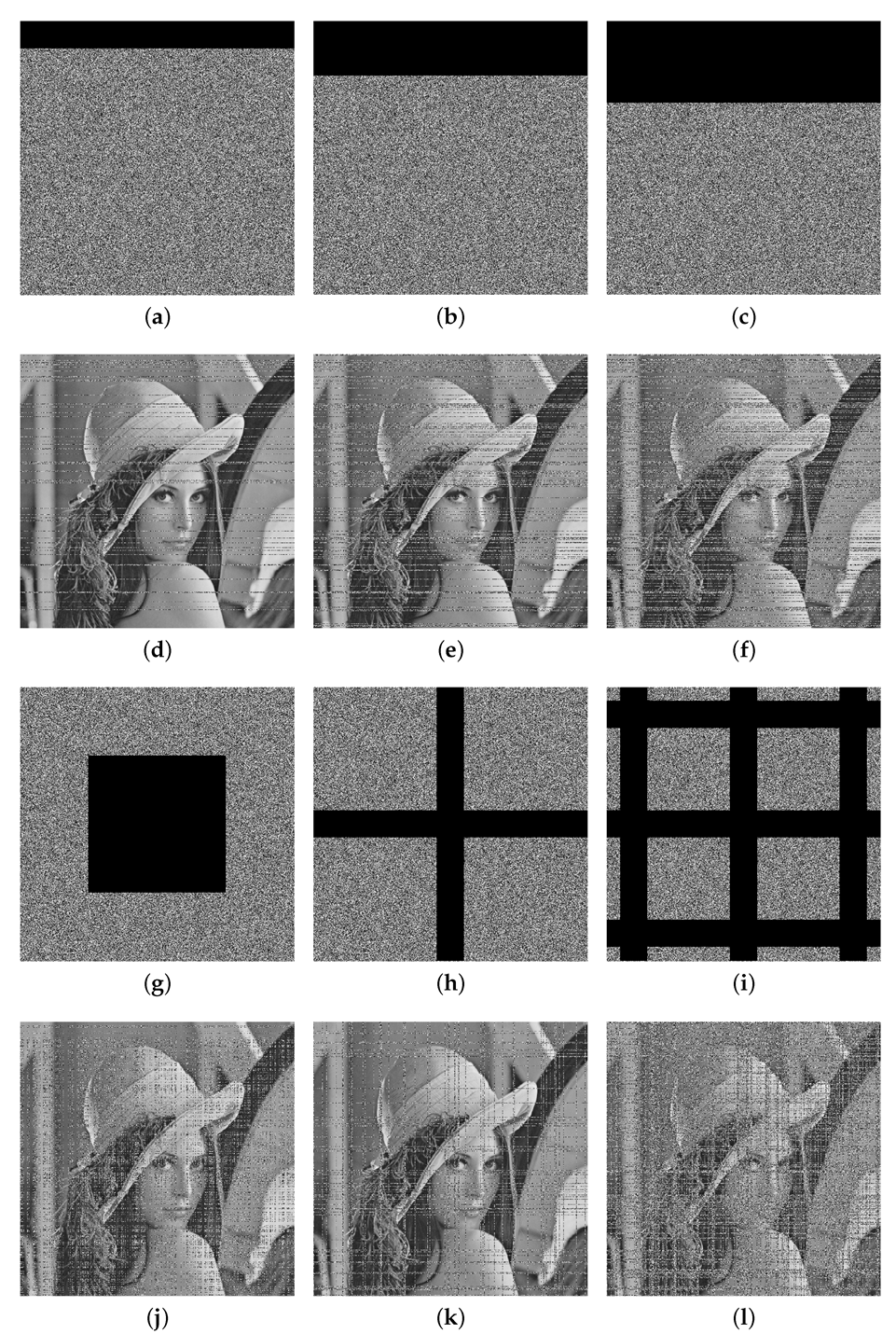Author Contributions
Conceptualization, H.Z.; data management, S.C.; formal analysis, X.X.; access to funds, S.C.; survey, X.X.; methodology, Q.H. and H.Z.; project management, H.Z.; software, Q.H.; supervision, H.Z.; verification, Q.H.; visualization, Q.H.; writing—manuscript, Q.H.; writing—review and editing, L.H. and H.Z. All authors have read and agreed to the published version of the manuscript.
Figure 1.
The Banyan network. (a) The Banyan network. (b) The diffusion example in Banyan network.
Figure 1.
The Banyan network. (a) The Banyan network. (b) The diffusion example in Banyan network.
Figure 2.
The exchange unit.
Figure 2.
The exchange unit.
Figure 3.
The bifurcation diagram of 1-DSCM, 1-DFCS, and 1-DCP. (a) The bifurcation diagram of 1-DSCM with . (b) The bifurcation diagram of sin map with . (c) The bifurcation diagram of 1-DFCS with . (d) The bifurcation diagram of 1-DCP with .
Figure 3.
The bifurcation diagram of 1-DSCM, 1-DFCS, and 1-DCP. (a) The bifurcation diagram of 1-DSCM with . (b) The bifurcation diagram of sin map with . (c) The bifurcation diagram of 1-DFCS with . (d) The bifurcation diagram of 1-DCP with .
Figure 4.
The Lyapunov exponent of 1-DSCM, 1-DFCS, 1-DCP, and sin map with .
Figure 4.
The Lyapunov exponent of 1-DSCM, 1-DFCS, 1-DCP, and sin map with .
Figure 5.
(a) The sensitivity of the initial value. (b) The sensitivity of the control parameter.
Figure 5.
(a) The sensitivity of the initial value. (b) The sensitivity of the control parameter.
Figure 6.
The sample entropy of 1-DSCM, 1-DFCS, and 1-DCP with .
Figure 6.
The sample entropy of 1-DSCM, 1-DFCS, and 1-DCP with .
Figure 7.
The 0-1 test of 1-DSCM, 1-DFCS, and 1-DCP. (a) The 0-1 test of 1-DSCM with . (b) The 0-1 test of 1-DSCM, 1-DCP, and 1-DFCS with .
Figure 7.
The 0-1 test of 1-DSCM, 1-DFCS, and 1-DCP. (a) The 0-1 test of 1-DSCM with . (b) The 0-1 test of 1-DSCM, 1-DCP, and 1-DFCS with .
Figure 8.
The Banyan network-DNA mapping.
Figure 8.
The Banyan network-DNA mapping.
Figure 9.
The flow chart of our algorithm.
Figure 9.
The flow chart of our algorithm.
Figure 10.
Example of Banyan network diffusion operation.
Figure 10.
Example of Banyan network diffusion operation.
Figure 11.
The original and cipher images. (a) Lena gray image. (b) Encrypted image of gray Lena. (c) Lena color image. (d) Encrypted image of color Lena. (e) Baboon gray image. (f) Encrypted image of gray baboon. (g) Baboon color image. (h) Encrypted image of color baboon. (i) Sailboat gray image. (j) Encrypted image of gray sailboat. (k) Sailboat color image. (l) Encrypted image of color sailboat.
Figure 11.
The original and cipher images. (a) Lena gray image. (b) Encrypted image of gray Lena. (c) Lena color image. (d) Encrypted image of color Lena. (e) Baboon gray image. (f) Encrypted image of gray baboon. (g) Baboon color image. (h) Encrypted image of color baboon. (i) Sailboat gray image. (j) Encrypted image of gray sailboat. (k) Sailboat color image. (l) Encrypted image of color sailboat.
Figure 12.
The original, encrypted, and decrypted images. (a) The plain image. (b) The encrypted image. (c) The decrypted image with correct key. (d) The decrypted image with .
Figure 12.
The original, encrypted, and decrypted images. (a) The plain image. (b) The encrypted image. (c) The decrypted image with correct key. (d) The decrypted image with .
Figure 13.
The correlation coefficient of Lena. (a) Vertical correlation. (b) Horizontal correlation. (c) Diagonal correlation. (d) Antidiagonal correlation. (e) Vertical correlation of encrypted image. (f) Horizontal correlation of encrypted image. (g) Diagonal correlation of encrypted image. (h) Antidiagonal correlation of encrypted image.
Figure 13.
The correlation coefficient of Lena. (a) Vertical correlation. (b) Horizontal correlation. (c) Diagonal correlation. (d) Antidiagonal correlation. (e) Vertical correlation of encrypted image. (f) Horizontal correlation of encrypted image. (g) Diagonal correlation of encrypted image. (h) Antidiagonal correlation of encrypted image.
Figure 14.
The histogram analysis. (a) The natural image. (b) Histogram of the natural image. (c) The cipher image. (d) Histogram of the cipher image.
Figure 14.
The histogram analysis. (a) The natural image. (b) Histogram of the natural image. (c) The cipher image. (d) Histogram of the cipher image.
Figure 15.
Chosen-plaintext attack analysis. (a) All-black image. (b) Histogram of all-black image. (c) The cipher image. (d) Histogram of cipher image.
Figure 15.
Chosen-plaintext attack analysis. (a) All-black image. (b) Histogram of all-black image. (c) The cipher image. (d) Histogram of cipher image.
Figure 16.
The Salt and pepper noise attack of Lena. (a) 0.1 Salt and pepper. (b) 0.2 Salt and pepper. (c) 0.3 Salt and pepper. (d) Decryption image of (a). (e) Decryption image of (b). (f) Decryption image of (c). (g) 0.4 Salt and pepper. (h) 0.5 Salt and pepper. (i) 0.6 Salt and pepper. (j) Decryption image of (g). (k) Decryption image of (h). (l) Decryption image of (i).
Figure 16.
The Salt and pepper noise attack of Lena. (a) 0.1 Salt and pepper. (b) 0.2 Salt and pepper. (c) 0.3 Salt and pepper. (d) Decryption image of (a). (e) Decryption image of (b). (f) Decryption image of (c). (g) 0.4 Salt and pepper. (h) 0.5 Salt and pepper. (i) 0.6 Salt and pepper. (j) Decryption image of (g). (k) Decryption image of (h). (l) Decryption image of (i).
Figure 17.
The cropping attack of Lena. (a) Cropping attack (). (b) Cropping attack (). (c) Cropping attack (). (d) Decryption image of (a). (e) Decryption image of (b). (f) Decryption image of (c). (g) Cropping attack (). (h) Cropping attack (≈). (i) Cropping attack (≈). (j) Decryption image of (g). (k) Decryption image of (h). (l) Decryption image of (i).
Figure 17.
The cropping attack of Lena. (a) Cropping attack (). (b) Cropping attack (). (c) Cropping attack (). (d) Decryption image of (a). (e) Decryption image of (b). (f) Decryption image of (c). (g) Cropping attack (). (h) Cropping attack (≈). (i) Cropping attack (≈). (j) Decryption image of (g). (k) Decryption image of (h). (l) Decryption image of (i).
Table 1.
NIST test results of 1-DSCM.
Table 1.
NIST test results of 1-DSCM.
| Test Index | p-Value | Result |
|---|
| Frequency | 0.574903 | PASS |
| BlockFrequency | 0.114550 | PASS |
| CumulativeSums | 0.455937 | PASS |
| Runs | 0.275709 | PASS |
| LongestRun | 0.494392 | PASS |
| Rank | 0.739918 | PASS |
| FFT | 0.390936 | PASS |
| NonOverlappingTemplate | 0.719747 | PASS |
| OverlappingTemplate | 0.494392 | PASS |
| Universal | 0.867692 | PASS |
| ApproximateEntropy | 0.657933 | PASS |
| RandomExcursions | 0.634308 | PASS |
| RandomExcursionsVariant | 0.514124 | PASS |
| Serial | 0.262249 | PASS |
| LinearComplexity | 0.595549 | PASS |
Table 2.
Banyan network-DNA mapping rules.
Table 2.
Banyan network-DNA mapping rules.
| E1 | A | T | C | G |
|---|
| A | 11 | 01 | 10 | 00 |
| T | 01 | 11 | 00 | 10 |
| C | 10 | 00 | 11 | 01 |
| G | 00 | 10 | 01 | 11 |
Table 3.
NPCR and UACI analysis for plaintext sensitivity of different algorithms.
Table 3.
NPCR and UACI analysis for plaintext sensitivity of different algorithms.
| Algorithm | Image | NPCR | UACI | Result |
|---|
| | Size | | | |
| Ours | Lena256 | 100 | 34.5079 | PASS |
| | Baboon256 | 100 | 33.4653 | PASS |
| | Airfield256 | 100 | 34.2185 | PASS |
| Ref. [10] | Cameraman256 | 99.6414 | 33.5156 | PASS |
| | Pepper256 | 99.5926 | 33.4412 | PASS |
| | fabio256 | 99.6158 | 33.3941 | PASS |
| Ref. [12] | Lena256 | 99.6170 | 33.4828 | PASS |
| Ref. [23] | Lena256 | 99.6063 | 33.2830 | PASS |
| | Baboon256 | 99.5865 | 33.3835 | PASS |
| | Camera256 | 99.5987 | 33.4316 | PASS |
| Ref. [27] | Lena256 | 99.6166 | 33.4476 | PASS |
| Ref. [28] | Lena256 | 99.0017 | 32.1443 | FAIL |
| | Size | | | |
| Ours | Lena | 100 | 33.6941 | PASS |
| | Baboon | 100 | 33.8055 | PASS |
| | Airfield | 100 | 34.7584 | PASS |
| | Black | 100 | 33.9145 | PASS |
| Ref. [10] | Lena | 99.5922 | 33.4408 | FAIL |
| | Boat | 99.6117 | 33.5061 | PASS |
| | Baboon | 99.6002 | 33.4628 | PASS |
| Ref. [12] | Lena | 99.6170 | 33.4828 | PASS |
| Ref. [23] | Lena | 99.6178 | 33.4412 | PASS |
| | Baboon | 99.6004 | 33.4522 | PASS |
| | Peppers | 99.6197 | 33.4957 | PASS |
| Ref. [27] | Lena | 99.6099 | 33.4511 | PASS |
| Ref. [28] | Lena | 99.0631 | 33.4859 | FAIL |
Table 4.
Key sensitivity analysis.
Table 4.
Key sensitivity analysis.
| Key | | | | | |
|---|
| NPCR | 99.6085 | 99.6047 | 99.6151 | 99.6170 | 99.6155 |
| UACI | 33.4735 | 33.4683 | 33.5749 | 33.4580 | 33.4684 |
Table 5.
Correlation analysis of original images and encrypted images.
Table 5.
Correlation analysis of original images and encrypted images.
| Algorithm | Image | Horizontal | Vertical | Diagonal |
|---|
| | | Original | Ciphered | Original | Ciphered | Original | Ciphered |
| Ours | Lena | 0.9851 | 0.0010 | 0.9722 | −0.0053 | 0.9622 | 0.0069 |
| | Baboon | 0.7398 | −0.0060 | 0.8764 | −0.0062 | 0.7185 | 0.0068 |
| | Airfield | 0.9423 | −0.0029 | 0.9014 | −0.0028 | 0.9103 | −0.0077 |
| Ref. [10] | Lena | 0.9851 | 0.0020 | 0.9722 | 0.0003 | 0.9622 | 0.0005 |
| | Baboon | 0.7398 | 0.0024 | 0.8764 | −0.0005 | 0.7185 | −0.0039 |
| | Boat | 0.9383 | 7.0253 × 10 | 0.9713 | −7.5260 × 10 | 0.9223 | −0.0016 |
| Ref. [12] | HeadCT | 0.9809 | −0.0212 | 0.9530 | −0.0111 | 0.9402 | −0.0075 |
| Ref. [23] | Lena | 0.9851 | 0.0019 | 0.9722 | 0.0007 | 0.9622 | 0.0038 |
| Ref. [27] | Lena | 0.9851 | −0.0018 | 0.9722 | 0.0038 | 0.9622 | −0.0006 |
| Ref. [28] | Lena | 0.9851 | 0.0031 | 0.9722 | −0.0034 | 0.9622 | −0.0326 |
Table 6.
test result of gray images .
Table 6.
test result of gray images .
| Image | | Result | Image | | Result |
|---|
| Baboon | 234.4807 | PASS | Lena | 210.1808 | PASS |
| Airfield | 250.4073 | PASS | Flower | 284.6099 | PASS |
| Fruits | 255.3760 | PASS | Pepper | 250.3575 | PASS |
| Sailboat | 255.3752 | PASS | Black | 170.4671 | PASS |
Table 7.
The information entropy of gray images.
Table 7.
The information entropy of gray images.
| Image | Airfield | Baboon | Lena | Flower | Fruits | Pepper | Sailboat |
|---|
| Original | 7.1206 | 7.3585 | 7.4455 | 7.6900 | 7.3644 | 7.3063 | 7.2673 |
| Cipher | 7.9992 | 7.9993 | 7.9994 | 7.9993 | 7.9992 | 7.9993 | 7.9993 |
Table 8.
Time required for encryption (in seconds) of each gray image.
Table 8.
Time required for encryption (in seconds) of each gray image.
| Image Size | Ours | Ref. [10] | Ref. [12] | Ref. [23] | Ref. [27] | Ref. [28] |
|---|
| 0.5043 | 1.4765 | 0.7449 | 2.5089 | 0.9256 | 4.5621 |
| 0.1295 | 0.1824 | 0.4480 | 0.6495 | 0.2764 | 2.1100 |
Table 9.
PSNR value of cipher image.
Table 9.
PSNR value of cipher image.
| Algorithm | Image | PSNR |
|---|
| Ours | Lena | 9.2517 |
| | Baboon | 9.2073 |
| | Airfield | 8.4064 |
| | Flower | 8.3428 |
| | Fruits | 8.7510 |
| | Pepper | 8.4398 |
| | Sailboat | 8.4687 |
| Ref. [10] | Lena | 9.2878 |
| | Baboon | 9.4006 |
| Ref. [12] | Lena | 10.4370 |
| Ref. [23] | Lena | 9.6028 |
| Ref. [27] | Lena | 9.5399 |
| | Sailboat | 9.2962 |
| Ref. [28] | Cameraman | 10.6250 |
| | Plain white | 10.4563 |
Table 10.
PSNR value of noise attack.
Table 10.
PSNR value of noise attack.
| Type of Attack | PSNR |
|---|
| Salt & pepper noise (0.1) | 19.5317 |
| Salt & pepper noise (0.2) | 16.1517 |
| Salt & pepper noise (0.3) | 14.9478 |
| Salt & pepper noise (0.4) | 13.5630 |
| Salt & pepper noise (0.5) | 12.4120 |
| Salt & pepper noise (0.6) | 11.3858 |
| Gaussian noise (0.01) | 14.4505 |
| Figure 17a cropping attack () | 19.2930 |
| Figure 17b cropping attack () | 16.7923 |
| Figure 17c cropping attack () | 14.4860 |
| Figure 17g cropping attack () | 15.5209 |
| Figure 17h cropping attack (≈) | 16.5307 |
| Figure 17i cropping attack (≈) | 12.4853 |
